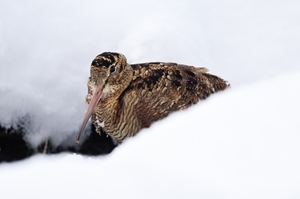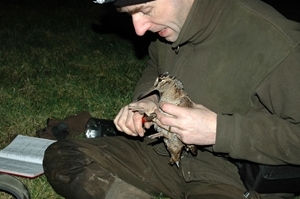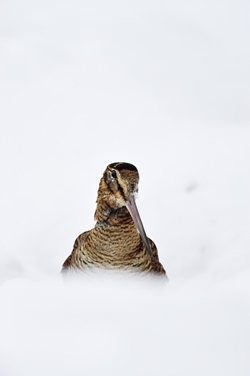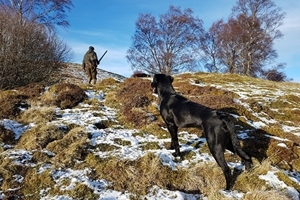Key points
- Woodcock feed on earthworms and other insects or larvae in the soil, by probing with their long bills. When the ground is frozen, feeding becomes difficult and can be impossible during cold spells when the ground remains frozen day and night.
- Energy reserves stored as fat and muscle can help them endure cold periods without food, or can fuel escape flights to warmer areas.
- This study looked at the energy reserves of 221 shot birds and 1,689 birds that were caught and then released, to calculate how long they would be able to fast, or how far they would be able to fly using stored energy.
- The scientists also looked at weather information to understand better how cold periods affect the energy stores of woodcock.
- If woodcock stayed in the same location, the average fast that birds could survive was six days.
- If woodcock left when cold weather began, they could fly on average 860km using the energy reserves they had.
- As woodcock can starve to death in less than a week during continuous frozen conditions, this study recommends that woodcock shooting should stop after four days of freezing weather, rather than the previously recommended voluntary restraint after seven days.
Background
 Woodcock are migratory birds that travel from their breeding grounds in Scandinavia, Finland and Russia to warmer climates in southern and western Europe for the winter. Many birds spend the winter in Britain. Woodcock are hunted across Europe, with most being shot in France, Italy, Britain, Ireland and Spain. For conservation, they are classified as being of ‘least concern’ at a European level, but in some areas, including Britain and Switzerland, breeding numbers have been declining, and in the UK they were recently added to the Red List for birds of conservation concern.
Woodcock are migratory birds that travel from their breeding grounds in Scandinavia, Finland and Russia to warmer climates in southern and western Europe for the winter. Many birds spend the winter in Britain. Woodcock are hunted across Europe, with most being shot in France, Italy, Britain, Ireland and Spain. For conservation, they are classified as being of ‘least concern’ at a European level, but in some areas, including Britain and Switzerland, breeding numbers have been declining, and in the UK they were recently added to the Red List for birds of conservation concern.
Woodcock build up fat reserves to store energy for the winter, which helps them keep warm and sustains them through lean periods to prevent starvation. Woodcock feed by probing the ground with their bills for food, which consists mainly of earthworms and leatherjackets (the larvae of daddy-long-legs) but also other insects, larvae and spiders. This feeding technique means that the ground must be soft for them to feed. Freezing conditions mean that feeding becomes more difficult and can be impossible if the ground is frozen all day.
To reduce the disturbance caused by shooting, as well as direct mortality to waders and waterfowl, regulations and restrictions on shooting in cold weather are in place, although they are different in different countries. In Britain, voluntary restraint is recommended after seven consecutive days of frozen conditions being recorded at half of a network of 25 coastal monitoring stations (a minimum daily air temperature less than 1°C, and minimum daily grass temperature less than -2°C). However, this does not become a legal restriction until day 15, and the impact of frozen conditions on woodcock are not well understood.
This study looks at the woodcock’s energy reserves, which tells us their potential for either surviving cold periods when woodcock cannot access food, or their capacity to make escape flights to warmer areas.
What they did
 GWCT scientists looked at the energy reserves of 1,910 woodcock between 2010 and 2016. 221 of these were birds that had been shot and were sent to us for analysis, which were weighed and measured. The abdominal and intestinal fat was dissected out and weighed, as well as the pectoral muscles. These are both good indicators of body condition and energy reserves. The other 1,689 birds were live caught at night by dazzling with a lamp. They were aged, weighed, their wing length was measured, and they were fitted with an identifying leg ring. These two sets of information were used to calculate energy reserves for the birds. This was then used to estimate how long a bird could fast, or how far it could fly to escape cold weather.
GWCT scientists looked at the energy reserves of 1,910 woodcock between 2010 and 2016. 221 of these were birds that had been shot and were sent to us for analysis, which were weighed and measured. The abdominal and intestinal fat was dissected out and weighed, as well as the pectoral muscles. These are both good indicators of body condition and energy reserves. The other 1,689 birds were live caught at night by dazzling with a lamp. They were aged, weighed, their wing length was measured, and they were fitted with an identifying leg ring. These two sets of information were used to calculate energy reserves for the birds. This was then used to estimate how long a bird could fast, or how far it could fly to escape cold weather.
Another aspect of this study was looking at the local weather conditions (from weather stations within 15 kilometres), where the night temperatures and windchill were recorded from the week before the capture or shooting of each bird. This information was used to look at how weather conditions affected the bird’s weight and energy reserves.
More examination of the effect of temperature was done by looking at cold spells, when the minimum daily temperature was below 0°C at the site of capture and ringing. Information was recorded for birds caught or shot for the five days before, during and the five days following the cold spell. This study looked at the effect of temperature on energy reserves, and the effect of cold spells, including how long and how cold they were.
What they found
 Birds in their first winter had slightly lower energy reserves than older, adult birds. Birds shot in Cornwall had less energy stored than those from the other regions in the study (East Anglia, Wessex, Western Scotland). All shot birds could fast for three days, the average length of fast that Cornish birds could endure was 5 days, and in other regions it was 6.4 days. Or, if the stored energy was used in escape flight, all birds could have flown at least 600km; the average for Cornish birds was 781km and for those from other regions the average was 941km.
Birds in their first winter had slightly lower energy reserves than older, adult birds. Birds shot in Cornwall had less energy stored than those from the other regions in the study (East Anglia, Wessex, Western Scotland). All shot birds could fast for three days, the average length of fast that Cornish birds could endure was 5 days, and in other regions it was 6.4 days. Or, if the stored energy was used in escape flight, all birds could have flown at least 600km; the average for Cornish birds was 781km and for those from other regions the average was 941km.
If adults stayed in the same place when cold weather began, rather than starting an escape flight, the scientists estimated how many would have survived either a four- or a seven-day fast. The information from shot birds suggested that 80% would have survived a four-day fast and 9.5% would survive a seven-day fast. The data from birds caught live and released suggested that 93% would survive a four-day fast and 22% would survive a seven-day fast.
There were 19 cold spells in the study, which were an average of seven days long. The average daily temperature during these was -2.7°C.
The effect of weather on energy showed that cold spells led to a small drop in energy reserves of 6.7% on average, although this was more pronounced when the cold spells were longer and colder. Thus, during many cold spells, where the average daily temperature is no lower than -2.7°C, woodcock are able to find sufficient food to almost maintain their energy reserves, probably because there is some thawing of the ground during daylight hours.
What does this mean?
 Although woodcock can regulate their energy reserves quickly and efficiently when the ground is not frozen, the results from this study show that, when frozen conditions set in, woodcock may starve to death within a week.
Although woodcock can regulate their energy reserves quickly and efficiently when the ground is not frozen, the results from this study show that, when frozen conditions set in, woodcock may starve to death within a week.
The weather monitoring stations used to declare periods when it is too cold to shoot in Britain are located on the coast, where the temperature is typically 3°C higher than inland. This means that woodcock at inland sites are likely to be experiencing frozen conditions more frequently than when they are recorded at the weather stations. However, this study showed that during most cold spells woodcock could manage to feed for at least some time during the day. For instance, when the lowest daily temperature was -2°C, the average temperature was usually +2°C, a temperature at which the ground was thawed for feeding.
When cold spells hit, many migratory woodcock move further south and west, and they are sometimes seen leaving in the winter months. However, resident woodcock that stay in the UK year-round do not leave for warmer areas and are therefore likely to be more affected if shooting continues during or immediately after cold spells. The resident population is declining in Britain, and measures are taken to avoid shooting them, so this change in the mix of resident and migratory birds after cold spells may be important for the conservation of resident birds.
To reduce the combined effect of cold weather and shooting on woodcock, shooting should be restricted before energy reserves are depleted, and this study suggests that shooting of woodcock should stop after four days of continually frozen ground at inland sites, rather than the current recommendation of seven days. Restrictions should cover large regions and remain in place for seven days after the end of the cold spell. GWCT recommendations for voluntary cold weather restraint have been changed to reflect this advice and we urge those who shoot woodcock to respect them.
Read the original abstract
Sánchez-García, C., Williams, O., & Hoodless, A.N. (2018). Regulation of body reserves in a hunted wader: Implications for cold-weather shooting restrictions. Journal of Applied Ecology, 55: 2274-2284.
Further reading
Woodcock photo credit: Laurie Campbell